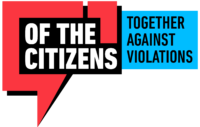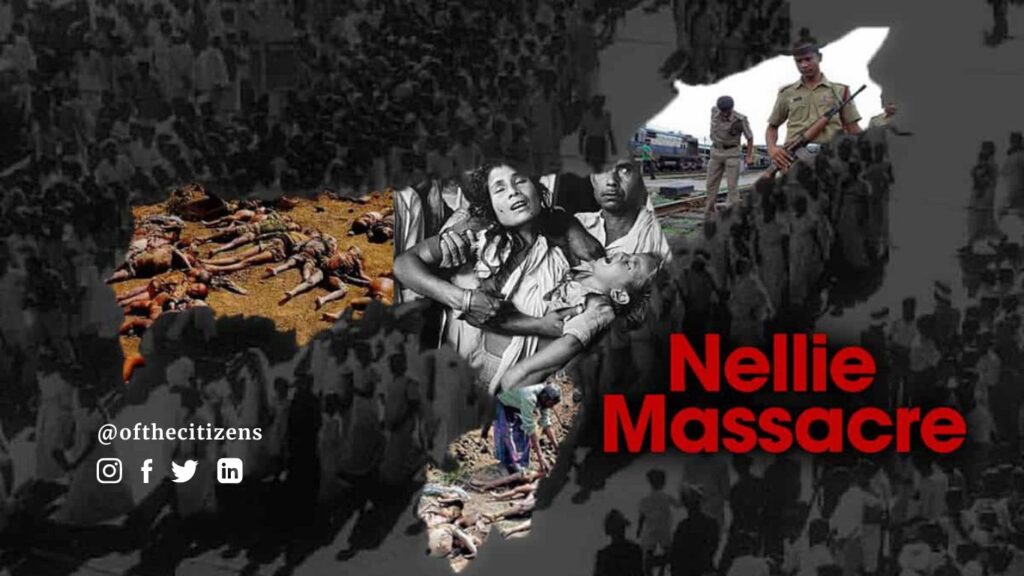Today, the Nellie massacre completes 40 years.
Thousands of Muslims were killed in the Nellie area of Assam in broad daylight on February 18th, 1983. Their only crime was that they exercised their democratic right to vote.
February 18, 1983, was a Friday, an important day for the people of the Islamic faith. The official report says the Nellie massacre left 1819 people dead and several thousand others injured. While unofficial sources and people of Nellie believe that the death toll could be around 5 thousand. In terms of brutality committed just in a few hours, probably this is the highest figure of people killed with crude weapons.
The question arises: could this massacre be avoided?
Several clues speak that state authorities were alerted of possible attacks on the minority community in Nellie. Several works of literature on Nellie have established that officials of the Home Ministry were alerted three days before the massacre about the possibility of the attack.
Diganta Sharma in his book, „Nellie 1983 ‟wrote that a message from Jiauddin Ahmed, OC of the then Nagaon police station sent an urgent message to Morigaon 5th Battalion Commandant, the sub-district police officer and OC of Jagiroad police station, Sri Nobo KChetia. This alert was completely ignored.
The message was, “INFORMATION RECEIVED THAT L/NIGHT ABOUT ONE THOUSAND ASSAMESE OF SURROUNDING VILLAGES OF NELLIE WITH DEADLY WEAPONS ASSEMBLED AT NELLIE BY BEATING OF DRUMS (,) MINORITY PEOPLES ARE IN PANIC AND APPREHENDING ATTACK AT ANY MOMENT (,) SUBMISSION FOR IMMEDIATE ACTION TO MAINTAIN PEACE (,).
This message gave a clear indication about the possibility of an attack on Nellie; still, thousands of innocents lost their lives within a few hours on Friday, February 18, 1983. Corroborating this negligence the National Police Commission in a report published on April 3, 1983, wrote, “The national police commission has found that there is a tendency among the police officer to shun responsibility for dealing with communal situations. They either avoid going to the spot or when they happened to be present there, they try not to resort to the use of force when the situation so demands or better still slip away from the scene leaving the force leaderless… (Sixth Report dealing with Recent Communal Riots and Role of the Police).
Who is the mastermind behind this massacre?
“The nationalist groups got information that on 14 February 1983 that many “Bangladeshi” People had cast votes in Nogaon (now Morigaon) district. Instantly, a plan of attack was made in the villages where Assamese people live surrounding Nellie by the initiative of agitating people. Strategies were formed as to how, when and where attacks would be made on the “illegal Bangladeshis”. The date was fixed for 18 February. The Agenda was genocidal to save the existence of mother Assam. The place of carrying out the plan was Nellie”.
India Today in its report on Nellie in 1983 pointed out that, “The All Assam Students Union (AASU) is believed to have played a very active part in the massacre…‟ The people of Nellie believe that the organized massacre of them was well organized by the agitators of the Assam Movement. The agitators fulfilled their ambition by inciting the neighbouring Tiwa community to carry out the carnage.
On April 10, 1983, the then Assam chief minister Hiteshwar Saikiaheld a press conference and released certain papers of AASU activists. Among these were papers prepared by AASU leaders on the religious minority inhabited areas. This report on the press conference was published at that time in a newspaper called, “Janakranti” on April 17, 1983. This proves how organized killing was carried out on people belonging to minority communities branding them as “foreigners”. The report also quoted Heteshwar Saikiaas saying,‟ activists of AASU, AGSP are involved in violent activities in the state”.
RSS Element Behind the Massacre?
Elements of RSS (Rashtriya Swayamsevak Sangh) involvement cannot be ruled out in the Nellie massacre. RSS and agitators of the Assam movement maintained a cordial relationship. An English magazine, On Lookers, brought this secret to light.
This was reflected in the article written by Partha Banerjee on the Assam agitation.‟ it is significant to mention here that the Volunteers Force constituted under the leadership of AASU was headed by Joynath Sharma who created controversy about his role in AASU. Not only that, soon after the Nellie Massacre several top leaders of AASU took resolution against him claiming his removal from AASU for maintaining relationships with RSS. It is worth mentioning here that a conference was held by AAS U at the premises of JB Law College, Guwahati on April 11-12, 1983 and a resolution was passed, the third resolution of this meeting was that”
The reports of Joynath Sharma having links with RSS are published in different newspapers like Sunday, India Today and many others newspapers. Joynath Sharma never filed any counterstatement on these reports.
Nellie massacre has enormous impacts on the Assam movement. The agitation was rushed to closure soon after the Nellie massacre. Assam Accord was signed and the Illegal Migration Determination Tribunal Act (IMDT) was passed in 1985. (Later on, in 2006, IMDT was declared unconstitutional.) Nellie, a forgotten massacre, is hardly a matter of discussion at present. The general opinion is that if Nellie is brought forth, there is a possibility of the emergence of communal tension. Still, a few questions remain unanswered. Legal proceeding remains unclear for the Nellie massacre. Charge sheeted cases were dropped to maintain communal harmony in the state.
No arrests were made. No one was made accountable for this massacre. The enquiry commission report became a secret document. Who will answer these questions? For governments, all files related to the Nellie massacre are closed now.
Nellie massacre reminds a famous Sarajevo joke, “When someone kills a man, he is put in prison. When someone kills twenty people, he is declared mentally insane. But when someone kills 2,00,000 people, he is invited to Geneva for peace negotiations”. There will be no better example of this joke except the Nellie massacre.
Below is the calendar for the Month of February which an insight into how the massacre unfolded and the aftermath
Diary: February 1983
February 1
- All Assam freedom fighters convention under the leadership of ASSU and AGSP.
- Supreme Court rejected Raj Narayan‟s plea for the postponement of the election in Assam.
- Central Government announced Group Insurance benefit for the officials and workers from Assam and outside taking part in the election.
- Bomb blasts in various places in Assam in protest of the election.
- Several footbridges and bridges were torched.
- Market burnt down in Dhekia Juli, Sonitpur district
- Group clash in Kamalpur
February 2
- Police fired at Bordoulguri and Jonaram of Mangoldoi sub-division. 5 killed.
- ASSU alleged that CRPF threw three boys while a bridge was torched.
February 3
- Leaders of the movement declared general non-cooperation of the official programs scheduled from February 5- 22.
- Police fired on civilians protesting the election at Bura, Darrang district. Few killed.
February 4
- Police firing at North Lakhimpur. Several wounded.
- Teachers gathered in protest of the election.
- Wooden bridges burnt down in several places in North Lakhimpur, Darrang and Nagaon
- The body of the supporter of CPI (ML) recovered from Ranjali Reserve, Sivsagar
February 5
- Plying of both private vehicles and state vehicles was stopped.
- Police firing on election protester at Tongla. 4 killed
- 36-hour bandh at Karbi Anglong by two student organizations.
- Bomb blasts at a few places
- Bandh in Dibrugarh district
- The Centre decided to send 30 battalions of CRPF to Assam.
February 7
- Public meeting at Guwahati Judge field by the left parties
- Police SI Bipin Mahanta was killed in cross-firing by opposition people in Tezpur
- Jorhat judge Nurul Haq kidnapped by miscreants
- The dead body of a Congress worker recovered at Tingkha of Dibrugarh district
- Police – CRPF firing at Titkuri. Several wounded.
- The central government decided to send additional BSF and CRPF teams to Assam.
February 8
- 7 killed in Belsar, Nalbari following police firing in a rally.
- Bomb blast at Lanka, 3 killed and another 23 injured.
- 7000 employees proceeded towards Assam from different parts of India to hold the election in Assam.
- BJP leaders like Chodhari Charan Singh and Yashvant Singh under the leadership of A.B Vajpayee conducted a rally against the election at Judge filed, Guwahati.
February 9
- A bomb was thrown at Chand Mohammed, an ex-speaker of the Assam state Assembly at Athuaguri.
- Police fired at the rallies against the election at Kamarkuchi, Samata of Nalbari district –5 and 2 killed respectively.
- M Rehman was suspended from PWD following a disagreement to build a helipad in Moirabari to be used by the then PM Indira Gandhi for election purposes.
- People were killed here and there following protests in various parts of Assam
- Curfews were imposed in many places.
- ASSU announced its program boycotting the election and the arrival of the PM in Assam.
February 11
- Police fired at Nalbari, Barpeta etc. 3 killed them.
February 12
- Communal violence erupted in Assam in several places in Assam. Several houses belonging to minority communities burnt down in and around Boko of Kamrup district and gave birth to communal clash. 9 killed.
- Indira Gandhi spoke at an election rally at Maligaon under strict security arrangements.
February 13
- The communal clash continued in places like Bokulguri, Jagiroad, Lahorighat, and North Lakhimpuretc. Several were killed in police firing and bomb blasts.
February 14
- Election held. Police fired to control the protesting mass in different places. A total of 19 were killed.
- 30 villages burnt down in Darang district.
- Communal clash in Jamunamukh, Nagaon district and Kamrup district
February 15
- Congress-I candidate Satya Narayan of Bishwanath Chariali was killed by people protesting the election.
- Communal clash at Goalpara, Nogaon, Darrang etc. Houses were torched and several were killed in police firing.
February 16
- Dayanath Sharma, brother of Joynath Sharma, head of the All Assam Volunteers Force killed at Chawolkhowa Chapori and another 85 were killed that night.
- Communal clash in DoomDooma. 7 killed.
- Police and CRPF clash at Goalpara. 6 killed in the clash.
- Houses burnt down in Dhubri and Nalbari
February 17
- Election held for the second phase in 36 state assembly seats and 11 Lok Sabha constituencies.
- The communal clash continued and several were killed. Houses torched.
February 18
- Organised massacre at Nellie of Nagaon district. About 2 thousand killed. 16 villages belonging to minority communities burnt down.
- Communal clash at Darrang district. 26 were killed and four were killed in police firing.
- Several clashes in different parts of Assam. Many were killed and injured.
February 19
- Attack on linguistic minority at Gareshwar of Kamrup district. Several injured.
- Communal clash at Abhayapuri.
- The Lok Sabha election was completed in 24 constituencies.
February 21
- Indira Gandhi visited Nellie and Gohpur.
- About 2 thousand people belonging to linguistic minorities fled to West Bengal for safety from Goreshwar, Kamrup.
- 48 dead bodies were recovered from different parts of Kamrup
February 22
- Peres de Queler, UN secretary-general expressed shock over the Nellie massacre.



